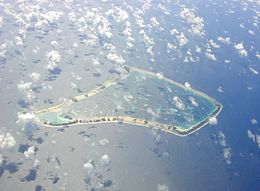|
Fakaofo
Fakaofo, formerly known as Bowditch Island, is a South Pacific Ocean atoll located in the Tokelau Group. The actual land area is only about 3 km2 (1.1 sq mi), consisting of islets on a coral reef surrounding a central lagoon of some 45 km2. According to the 2006 census 483 people officially live on Fakaofo (however just 370 were present at census night). Of those present 70% belong to the Congregational Church and 22% to the Catholic Church.[2] Geography and government The main settlement on the island is Fale on Fale Islet, towards the western side of the atoll. Located two kilometres to the west of it is the relatively large Fenua Fala Islet, where a second settlement was established in 1960. Other islets in the group include Teafua, Nukumatau, Nukulakia, Fenua Loa, Saumatafanga, Motu Akea, Matangi, Lalo, and Mulifenua. Fakaofo's Council of Elders is made up of citizens over the age of 60. History The island was sighted by the whale ship General Jackson in 1835 and named DeWolf Island after their ship's owner. The General Jackson returned in 1839. The island was then named Bowditch (after Nathaniel Bowditch), this island was visited by the American ship USS Peacock which was part of the first American voyage of discovery – The United States Exploring Expedition (also known as "the Ex Ex" or "the Wilkes Expedition"), 1838–1842, United States Navy Lieutenant Charles Wilkes commanding.[3] Nathaniel Bowditch (1773–1838) was a noted American navigator who wrote a famous two-volume encyclopedia of navigation and sailing that is still used and published today by the Defense Mapping Agency Topographic Center (DMATC). In Twenty Years Before The Mast,[4][a] Charles Erskine wrote "The people found on this island had no knowledge of fire, which I believe, is the only instance of the kind on record." In a village on the island is a coral slab monument personifying Tui Tokelau, a god once worshiped in the islands. In 1889, Fakaofu and several other Tokuelauan islands were claimed by Great Britain as part of the Union Islands.[5] In 1916, the Union Islands were annexed to the Gilbert and Ellice Islands colony and then, in 1925, reassigned to the Dominion of New Zealand under the administration of Territory of Western Samoa.[6] Unlike Atafu and Nukunono, no U.S. claims under the Guano Island Act were ever made on Fakaofu.[7] Despite this, in 1979, as part of the Treaty of Tokehega, the U.S. formally renounced its prior claim on all Tokelauan islands now under New Zealand sovereignty, including Fakaofu, and a maritime boundary between Tokelau and American Samoa was established.[8] Climate crisisFive-metre high concrete walls surround one of Fakaofo's atolls, that were constructed by residents to protect the islet from rising sea levels.[9] List of islands
Notes
See alsoReferences
External linksWikimedia Commons has media related to Fakaofo. |
||||||||||||||||||||||||||||||||||
Portal di Ensiklopedia Dunia




